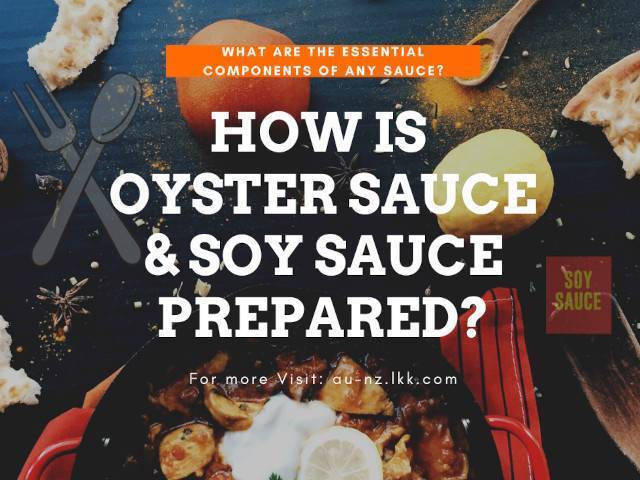Oyster Sauce and Soy Sauce

How is Oyster Sauce and Soy Sauce prepared?
A sauce is a flavourful liquid or semi-solid substance that is used to season, flavour, and enhance food taste. Along with taste enhancement, a sauce will also help provide uplift the food appearance and odour.
What are the essential components of any sauce?
The below mentioned three components need to be included in a specific proportion. A slight change in the composition will spoil the texture, colour, and taste of the food.
• A liquid that will be the significant components of the sauce
The most commonly used liquid agents are white stock, brown stock, milk, tomato stock, and clarified butter. The liquid plays a significant role in the colour of the sauce.
• A thickening agent that will provide a semi-solid texture to the sauce.
A thickening agent needs to be chosen to get the desired sauce thickness. Also, the thickening agent will affect the taste of the sauce. Hence, make sure that the thickening agent you use does not let you compromise the food taste. The most commonly used thickening agents are roux, beurre manie, whitewash, and slurry. Roux is a cooked combination of the same parts of fat and flour. Beurre manie is made up of equal proportions of flour and butter. Whitewash is a light mixture of any kind of flour and water. A thin mixture of cornstarch and cold water is known as the slurry. The slurry is the most commonly used thickening agent for the sauce. Arrowroot, waxy maize, breadcrumbs, and purees are also used as thickening agents.
• Seasoning and flavouring agents
You can add different flavouring agents to a simple sauce and customize its taste according to your palate, for e.g. The basic mayonnaise sauce can have mustard or mint added for enhancing the flavour.
The perfect sauce composition must not be too thick or thin. The ideal consistency must help coat the back of your spoon. It must have the right flavour balance and should not be very starchy. The colour should be aesthetically pleasing and must make the food look tasty. There are many different types of sauces available. Here are a few factors based on which you can classify sauces:
1. The serving temperature
2. The prominent flavour
3. The acidity level in the sauce
4. By sweetness/ sourness
5. By colour
The five main sauces are Bechamel Sauce, Veloute Sauce, Espagnole Sauce, Hollandaise Sauce, and Tomato Sauce.
Oyster Sauce
Oyster Sauces is majorly made up of oyster extracts. It gives a robust flavour and a rich colour. Oyster sauce is mostly used in Chinese cuisines. The sauce is goldish brown with a thick consistency. Chinese, Thai and Vietnamese cuisines also make good use of oyster sauce for a variety of cooking like marinating and stir-frying.
Composition of oyster sauce-
Main ingredient - oyster extracts
Despite the key ingredient being oyster extracts, the sauce doesn't have a fishery taste. The boiled oyster juices are caramelized that nullifies the strong oyster flavour. The oyster extracts are mixed with the right proportion of salt and sugar. In some cuisines, the consistency of the sauce is made thicker by adding cornstarch.
The vegan version of oyster sauce is specially created for vegans to enjoy a similar texture and appearance of dishes like what oyster sauce can do in Chinese cooking. It is a mixture of soy sauce, dried mushrooms, sugar and salt.
How to use oyster sauce in your food preparation?
Oyster sauce has a powerful flavour. You can start with a small amount of oyster sauce first, then increases the amount to your desired taste. Do not overwhelm the taste of a dish by adding more than you need, the easiest way is to follow the recipe.
Soy Sauce
Soybeans are the main ingredient of soy sauce. The different types of soy sauce are:
Light Soy Sauce
A light soy sauce has a clear with a light reddish brown colour. Mainly used for seasoning; ideal as a marinade for meat, dressing for cold dishes, as dip, daily condiment and seasoning for stir-fries.
Dark Soy Sauce
The dark soy sauce consists of caramel and is slightly sweet in flavour. Mainly for adding colour to dishes; goes particularly well with red-cooked stews, casseroles, and hearty Northern Chinese dishes.
Japanese Soy Sauce
Japanese soy sauce uses defatted soybeans and a higher percentage of wheat for fermentation. It has a relatively strong wine-like aroma and taste. Less suitable for marinates or stir-fries.
Kecap Manis
This soy sauce is native to Indonesia and has a thicker consistency.
The basic composition of soy sauce-
Soy sauce is usually prepared by fermentation or hydrolysis process. Traditionally, homemade soy sauce takes a lot of time. The soybeans are soaked and cooked by boiling. An equal amount of cooked soybean and roasted wheat is added and aspergillus spores are added to it. This cultured mixture is mixed with salty brine for wet fermentation. Fermentation produces a lot of gut-friendly bacteria in the soy sauce. A cloth piece is used to separate the liquid and solid components in the fermented mixture. Pasteurization is employed to the liquid components by heating them to remove any active yeasts.
Preparing soy sauce at home is a very time-consuming process. Lee Kum Kee Premium Sauce range solves this for you, Their soy sauce is made with Non-GM soybean, using traditional craftmenship in automated production lines for high quality control from farm to fork. Lee Kum Kee ensures the authenticity and taste of soy sauce.
Simply, Lee Kum Kee provides the high quality key Chinese sauces to your daily cooking.
*Photo by GoodEats YQR on Unsplash
MORE



